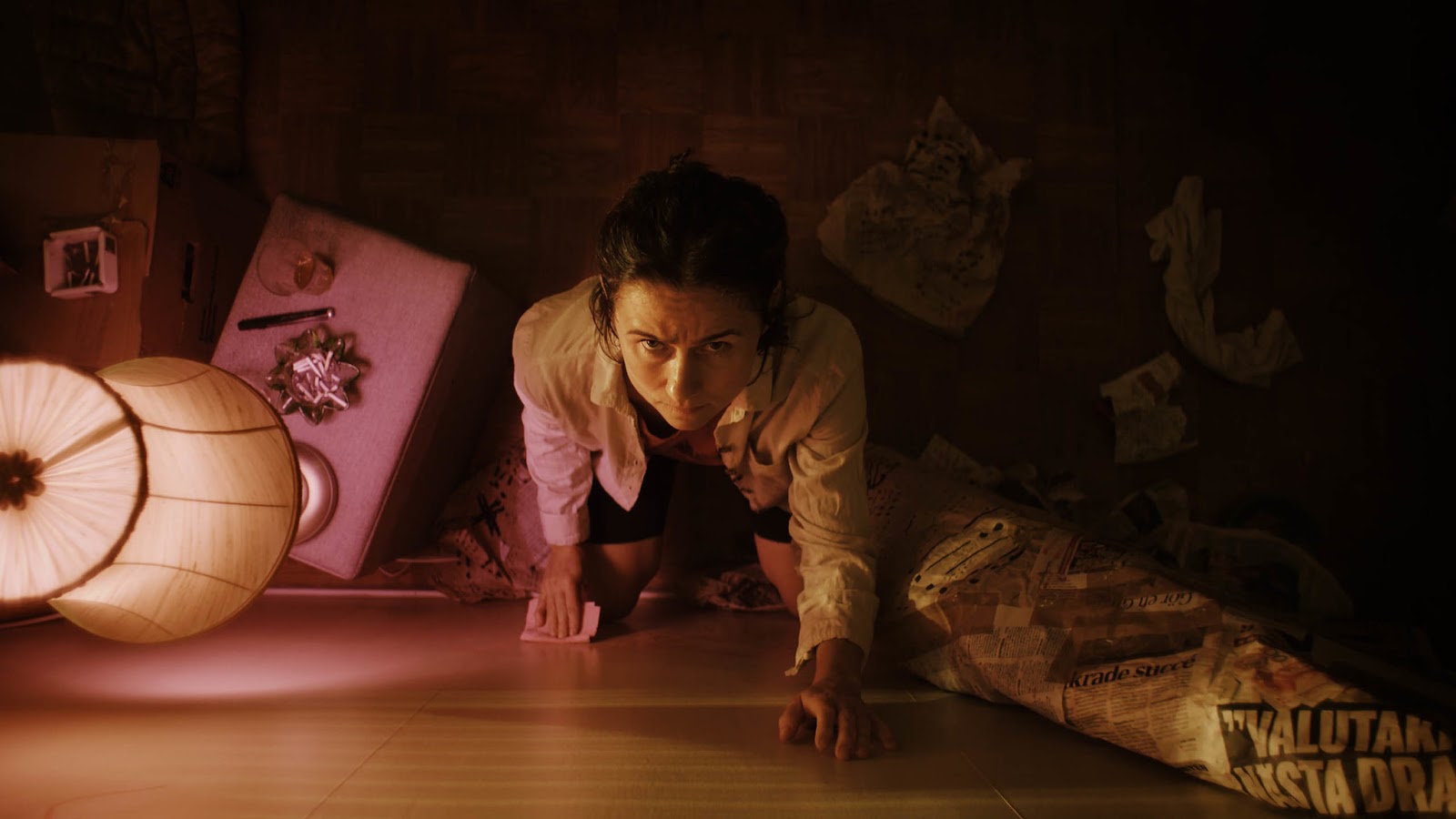
18 Mar ‘Knocking’ Examines the Horrors of Gaslighting and Vulnerability in Mental Illness
BY GABE CASTRO
**This article contains spoilers**
Frida Kempff’s debut feature Knocking gets under your skin the way an incessant noise that only you can hear does. Following a woman recently released from a mental health facility after experiencing a traumatic event, Kempff explores the vulnerability of mental illness, the anxiety caused by being gaslit, and the strength in persevering despite all odds. Molly is never truly a reliable narrator, but we can find empathy in our descent into uncertainty alongside her.
Kempff provides us with an intimate character study. Molly, brilliantly played by Cecilia Milocco, moves into a new apartment after recovering in a psychiatric hospital. This apartment is bare and isolated, becoming an extension of the hospital: swapping out orderlies and attendants for concerned and aggravated neighbors. Despite the isolation, Molly seems to be doing well. She is convinced of her recovery and often repeats the mantra, “I am better now.” She spends her days watching the world from her balcony, not quite ready to reenter society but happy to watch it from a safe distance. She greets neighbors and settles in comfortably–until the knocking commences.
Late at night, a knocking only she can hear keeps her awake. At first, it is simply an annoyance. She complains to the building manager and the neighbors who she deems responsible, but is met immediately with denial. Even as viewers, we are left to question her mental stability as she begins to make increasingly desperate and questionable decisions, such as rummaging through a neighbor’s trash or creating an elaborate conspiracy board on the wall of her apartment. This new environment is a catalyst for Molly as she descends further into madness. The knocking evolves to include a reappearing stain on her ceiling and the sound of a woman crying from the vents in her bathroom. With that, her desperation to save the woman above and to simply be taken seriously escalates.

Molly’s breakdown is gradual but constant. As a viewer, watching her get dismissed at every turn is extremely frustrating. Surrounded by Martin Dirkov’s immersive, creeping score, deceptive visuals appear in the form of a recurring stain or even events that Molly experiences only to later find out they never happened. The camera serves as a voyeur, capturing Molly in her desperate, private moments. Viewers lurk with Molly in these intimate, suffocating spaces as the camera inches slowly in, closing her off further from reality and safety. Scenes reminiscent of Hitchcock’s Rear Window paint Molly in a paranoid light. She watches a woman in a building across the courtyard who might be a figment of her imagination, becomes suspicious of neighbors dumping bags of potentially bloody clothing, and even attempts to decipher the knocks as morse code.
Molly models a fierce perseverance that makes it hard to let her go. Even when the world is working hard to convince us that she is unwell, I couldn’t help but be suspicious of her neighbors, the police, and even the mental health facility’s doctors. The supporting characters use her mental health history to invalidate her experiences, but she sees herself as the knocking woman’s only hope. When the police refuse her calls, she seeks help from a welfare agency. We see her covered in grime from her late-night trash exploration and frantic from the neglect by those she looked to for protection and help. Molly isn’t only looking to save the woman above, but to save herself. In these moments when Molly is losing the thread, the stain grows, the noises warp, and the camera angles get increasingly disorienting. She holds onto one thought–she must save the woman above, and she’s the only one who can. Who better to save a woman desperately crying for help behind the walls than the woman crying for help on the other side?
Knocking provides a mouthpiece for the frustrations of women who have been historically gaslit due to the stigmas of mental illness. It isn’t the knocking that ignites Molly’s spiral into instability, but rather the blatant dismissal by those around her. In every attempt to uncover the truth she is thwarted by some excuse or flimsy explanation. At one point, even the police refuse to answer her calls and threaten her with arrest for false reports. Kempff’s decision to paint Molly as a victim the audience can’t entirely trust confronts the issues of gaslighting head-on. Although we know Molly is losing the plot, we are inherently distrusting of the supposed voices of reason around her. They are too quick to dismiss this woman due to her history and aren’t properly investigating the reports. The question of whether the knocking and the woman trapped above are real becomes the secondary issue. What we really want is for Molly to find confirmation of her own reality.

Molly’s loneliness allows her to sympathize with the woman knocking on her ceiling. She is plagued with flashbacks of the traumatic event that led to her institutionalization: losing her partner in an ocean-related death. Throughout the film, we are offered glimpses into a past with a happy, smiling and loved Molly. Wrapped in her partner’s arms and warmed by the sun, the flashbacks are radiant in color compared to the gloomy visuals of Molly’s present-day coping. We never learn exactly what happened to her partner but it’s easy to understand where Molly’s perseverance comes from. As she is running to rescue the woman pleading for help, she is also running to her partner. Molly is now the hero she couldn’t be then, for the woman above and for herself.
Horror has an unkind history of portraying mental illness, oftentimes using generalized and vague diagnoses to account for villain-like behavior. Kempff’s intention to unfold this story within the horror genre subverts the horror tropes of toxic mental illness representation. Further, it is an effective means of representing the ways in which women have been historically gaslit and invalidated. I am reminded of Charlotte Perkins Gilman’s The Yellow Wallpaper (1892), telling the tale of a woman left in isolation and driven mad by neglect and frankly, gaslighting behavior from her husband. A tale that sadly, still needs to be explored through media as a way of fighting back. In the final moments of the film, we as viewers are desperate for answers and crumbling in our resolve along with Molly. I think of the narrator in Perkins Gilman’s story, crawling behind the wallpaper, manifesting the maddened creature they told her she was. Kempff instead sets out to offer us validation through Molly’s experiences. Ultimately, viewers are left to wonder throughout the 78 minutes: is Molly an unreliable narrator or an unlikely hero?
Knocking, which premiered at Sundance in January 2021, has yet to be picked up for distribution. In the meantime, please enjoy these currently available films and TV shows with similar themes:
- Undone Streaming on Amazon Prime
- Crazy Ex-Girlfriend Streaming on Netflix
- The Babadook Streaming on Amazon Prime
- Wandavision Streaming on Disney+
- The Invisible Man Streaming on HBO Max
- Ingrid Goes West Streaming on Hulu
- Hereditary Streaming on Amazon Prime and Hulu

Gabe Castro is a Philadelphia-based multi-media creator specializing in the horror genre. By day, she works in public access television helping her community make people-powered media. By night, she is the producer and co-host of the horror media analysis podcast, Ghouls Next Door. She and fellow Ghoul, Kat, explore the unique and raw way society and culture influence film and media. Gabe believes media can be used as a tool to bring social change and works in all she does to create impactful and inspiring media. Gabe is also a co-host of the Black Tribbles, the award-winning geek talk radio show where she spends time with fellow BIPOC nerds. When she’s not hosting podcasts, she directs short horror comedies and designs terrifying soundscapes for the Black Women are Scary Podcast that celebrates people of color writing in horror.

Sorry, the comment form is closed at this time.